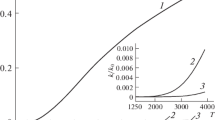Summary
-
1.
In the combustion of aromatic hydrocarbons, the engine combustion-chamber temperature is substantially higher than that with isoparaffins. Of the aromatics that were studied, benzene gives the highest combustion temperature and m-xylene the lowest.
-
2.
The combustion-chamber temperatures with AI-93 automotive gasolines (leaded and unleaded) with the same total aromatics content were practically identical, as was the temperature for a premium-grade gasoline.
-
3.
Adding an isoparaffinic component (alkylate) to a naphtha from cat reforming under severe conditions gave some lowering of engine cylinder and exhaust-gas temperatures.
Similar content being viewed by others
Author information
Authors and Affiliations
Additional information
Translated from Khimiya i Tekhnologiya Topliv i Masel, No. 2, pp. 45–47, February, 1972.
Rights and permissions
About this article
Cite this article
Zabryanskii, E.I., Grebenshchikov, V.P. Combustion temperatures of hydrocarbons and fuels. Chem Technol Fuels Oils 8, 138–140 (1972). https://doi.org/10.1007/BF00718985
Issue Date:
DOI: https://doi.org/10.1007/BF00718985




